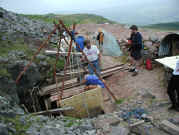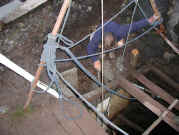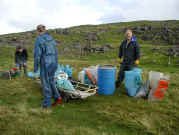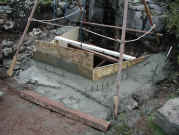
The first shuttering is lowered into position

Clark tamps down one of
the early concrete pours |
|
A lot of concrete
Over the August bank holiday and the week following, a
large team installed shuttering and concreted the shaft top. A mixer
and generator were brought up to the dig site by Land Rover and Range
Rover, together with all of the materials. Over the course of the
week, the Land Rover covered 136 miles between Penwyllt and Babysitters,
carrying cement, sand, gravel and rather ironically - water.
Many mixes later, the majority of the work had been done by the time the
weather broke on the Thursday.
The quantity of rain was sufficient to prevent Land Rover access all the
way up to the dig and materials then had to be manhandled up the final
slopes, all of which slowed down progress considerably. The winch
was set up half-way down and used to bring up the heaviest bags on a
redundant alloy rescue stretcher recovered from Penwyllt.
Foot and mouth disease
It had been the intention to complete the concrete work
at the surface before winter, but as ever, that was not to be. The
outbreak of foot and mouth disease in the following February prevented
access to Penwyllt until June and even then only under restricted
conditions.
It was not until May 2002 that operations at Babysitters Dig were to be
resumed. |
|

The
winch being used for equipment hauling

The final concrete level - to be this way until May 2002 |
